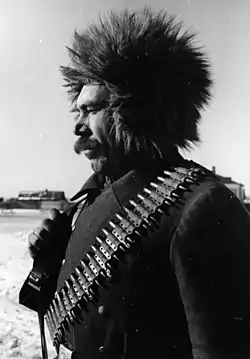Kalmykian Cavalry Corps
The Kalmykian Cavalry Corps (Oirat: Доктор Доллин Хальмг Мертэ Церг, German: Kalmücken-Kavallerie-Korps) was a unit of about 5,000 ethnic Kalmyk volunteers who chose to join the German Army in 1942 rather than remain in Kalmykia as German forces retreated before the Red Army.[1] Stalin subsequently declared the Kalmyk population as a whole to be German collaborators in 1943 and ordered mass deportations to Siberia suffering great loss of life.

Origins
When Erich von Manstein led the 16th Motorized Infantry Division into Kalmykia in early 1942 he already had some Kalmyk advisors from a committee drawn together by Goebbels for propaganda purposes. These were supplemented by other Kalmyks who had settled in Belgrade following their flight with White Russian emigres after the Russian October Revolution.
Organization
Kalmyk Kavallerie Korps acted within German Wehrmacht as an independent allied force with all leadership positions taken by Kalmyks. Most of the officers were Kalmyks themselves with previous Soviet military experience. A few Germans that were present within the corps performed only auxiliary and administrative functions.
Unlike most other national "volunteer" divisions, the Kalmykian Cavalry Corps incorporated genuine volunteers willing to fight together with Germans. The other national divisions relied upon recruits from POW camps.[2] More Kalmyks fought in the Kalmykian Cavalry Corps than in comparable units of the Soviet army.[3]
Military actions
The Kalmykian Cavalry Corps fought with the Wehrmacht behind the lines, especially around the Azov Sea. At the end of 1944, the surviving Kalmyk cavalry troops, together with their families, retreated with the German army.[3] About 2,000 went to Silesia, Poland and 1,500 to Zagreb, Croatia, where they were reorganized to fight against the partisans.
End of the war
After the war, nearly all of the surviving Kalmyk soldiers along with the Kalmyk families that accompanied them were forcibly repatriated to the Soviet Union.
The Kalmykian people were internally deported for 13 years as a punishment for collaborating with Germans.[4]
References
- J. Otto Pohl (1999). Ethnic Cleansing in the USSR, 1937-1949. Greenwood Press. pp. 61–65. ISBN 978-0-313-30921-2.
- J. Otto Pohl (1997). The Stalinist Penal System: A Statistical History of Soviet Repression and Terror, 1930-1953. McFarland. p. 96. ISBN 978-0-7864-0336-3.
- Rolf-Dieter Müller (28 February 2014). The Unknown Eastern Front: The Wehrmacht and Hitler's Foreign Soldiers. I.B.Tauris. pp. 248–249. ISBN 978-1-78076-890-8.
- Elza-Bair Mataskovna Gouchinova (11 January 2013). The Kalmyks. Routledge. p. 221. ISBN 978-1-135-77887-3.